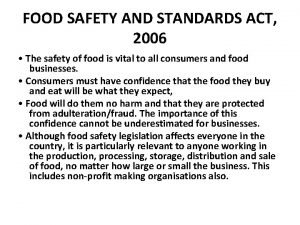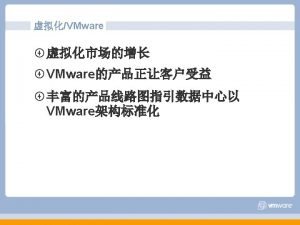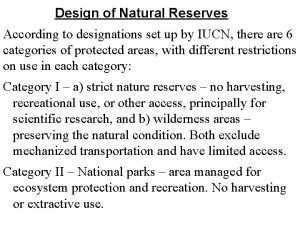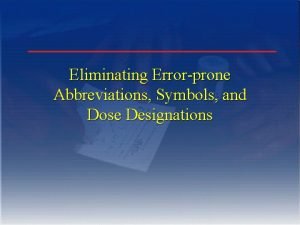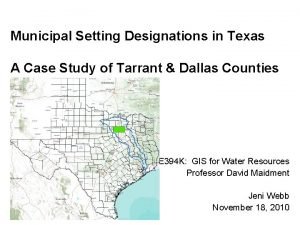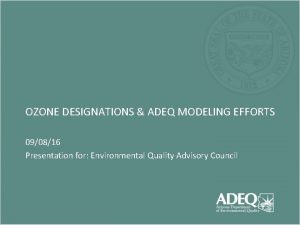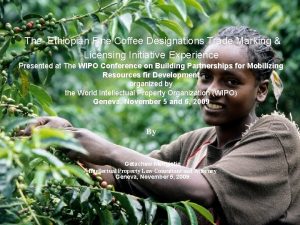Designations for the 2006 PM 2 5 Standards








![Air Quality - High Daily PM 2. 5 Concentrations Conceptual Diagram PM [µg/m³] 40 Air Quality - High Daily PM 2. 5 Concentrations Conceptual Diagram PM [µg/m³] 40](https://slidetodoc.com/presentation_image_h2/dc4f8221f291b8e744b4387c7d04ba1e/image-9.jpg)













- Slides: 22

Designations for the 2006 PM 2. 5 Standards: Evaluating the Nine Factors in Setting Nonattainment Area Boundaries Part 2 – Conceptual Model for Evaluating High PM 2. 5 Days and its Influencing Emission Sources Neil Frank EPA Office of Air Quality Planning and Standards For Presentation at EPA State / Local / Tribal Training Workshop: PM 2. 5 Final Rule Implementation and 2006 PM 2. 5 Designation Process June 20 -21, 2007 1

The 9 Designation Factors To Help Determine Nearby Area of Influence for 24 -hr NAAQS Violations Population and Urbanization Emissions Air Quality Traffic & Commuting Non Attainment Boundaries Current Emission Controls Meteorology Topography Growth Political and Other Boundaries Air Quality is one of the most Important Designation Factors 2

Topics to be Covered • • Conceptual model for high PM days Seasons when exceedances occur Composition of the high days Analytical tools – SLICE technique - for evaluating urban contributions to high days – Residence time analysis – for assessing nearby contributing source regions using back trajectories and emissions data – Gradient analysis – for identifying days with potential high source-oriented impacts 3

Conceptual Model for High PM 2. 5 Days • How to define high PM 2. 5 days? • What is the typical “daily increment” for high PM days in relation to the annual average? • What is the urban contribution above regional levels? 4

Conceptual Model for High PM 2. 5 Days What high PM 2. 5 days to consider? • “High PM 2. 5 Days” Associated with the 98 th percentile ü Not just one day per year ü Select all candidate days ü e. g. top 5% or days > 30 - 35 ug/m 3 ü Summarize by season to distinguish varying conditions 5

Conceptual Model for High PM 2. 5 Days High Daily PM 2. 5 has Urban and Regional Components 40 ug/m 3 Typical Daily Increment - Example 24 16 Example + PM 2. 5 High Day Value Seasonal Average Typical Daily Increment • The annual average PM 2. 5 (urban background) is the stuff that is there on a day-to-day basis. –Comes from nearby and more distant areas –Can be estimated by seasonal average PM 2. 5 concentration of non-high days –Includes contributions from all nearby surrounding counties –Can be estimated using the traditional urban increment approach • The daily increment (on top of annual average urban background) also has regional and local contributions. - Key issue: what counties and sources from the urban area contribute to the typical daily increment? 6

Conceptual Model for High PM 2. 5 Days An approach to partition typical levels into urban and regional components • Urban Increment Analyses as used 2004/2005 PM 2. 5 Designations • Urban sources in the Eastern US contribute at least 4 -6 ug/m 3 to annual average PM 2. 5 – • in Probably even larger urban contribution in western US cities Carbon is significant component of average PM 2. 5 mass, but metro area emissions typically are much less than SO 2 and NOx – Weighted emissions score developed to give additional weight to nearby direct carbon emissions as they contribute to the urban background 7

Air Quality - Annual Average PM 2. 5 Conceptual Diagram - Annual Average PM 2. 5 PM [µg/m³] 40 35 30 25 Urban areas ~14 -20 ug/m 3 Countryside ~10 -12 ug/m 3 20 15 10 urban increment regional contribution natural background 8 Western US urban areas may have smaller regional contribution
![Air Quality High Daily PM 2 5 Concentrations Conceptual Diagram PM µgm³ 40 Air Quality - High Daily PM 2. 5 Concentrations Conceptual Diagram PM [µg/m³] 40](https://slidetodoc.com/presentation_image_h2/dc4f8221f291b8e744b4387c7d04ba1e/image-9.jpg)
Air Quality - High Daily PM 2. 5 Concentrations Conceptual Diagram PM [µg/m³] 40 35 30 High Daily PM 2. 5 Concentrations Urban areas ~30 -40 ug/m 3 urban increment Countryside ~18 -30 ug/m 3 Larger “urban island” on peak days 25 20 regional contribution 15 10 natural background Focus of new analyses: understanding what emissions contribute to urban increment Western US urban areas may have smaller regional contribution 9

Conceptual Model for High PM 2. 5 Days Source region considerations • Role of Regional vs Urban vs Micro-scale Influences Air Quality – – – On high days particularly in the east, regional emissions often provide a “base” amount of pollution Urban-wide and nearby emissions also contribute significantly to high days: “urban island” effect In some cases, there may be a micro-scale effect from a single source or small group of sources • Does not help define NA boundaries, unless it is the only contributing source (Note: “urban” can mean large metropolitan area or smaller city) 10

Conceptual Model for High PM 2. 5 Days Seasons when exceedances occur • Time of Year for Exceedances- varies by Geographic Region – SE: Mostly summer – Industrial Midwest (IMW), Mid-Atlantic, So. CA: Winter and summer – NW, UT, NM, Middle CA: Mostly or exclusively Winter 11

% 50 NW UT IMW Percent of 2003 -05 FRM Days > 35 ug/m 3 by Month Based on all sites which violate 24 -hr NAAQS 25 0 J F M A M J J A S O N D Mid. Atl Mid CA J F M A M J J A S O N D % 50 S. CA J F M A M J J A S O N D La Cruces, NM SE 25 12 0

Conceptual Model for High PM 2. 5 Days Composition data are important 1) Composition Air Quality – Indicate which sources are contributing to average and high PM 2. 5 values • Varies across country – Warm season exceedances: Mostly sulfate + organic carbon – Cold season exceedances: Nitrate (at higher – latitudes and in Western US) + sulfate + carbon; Carbon may dominate in some locations (e. g. MT, ID) Gaps in speciation data for certain areas 13

Composition on Annual Average and High PM 2. 5 days have: High PM 2. 5 Days (From PM Staff Paper) Some source categories and regional influences may be Birm more important for high concentration days • • • Comparing average of 5 highest days during 2003, regional sources of sulfates and nitrates are larger contributors to peak day concentrations than to annual average (selected city analysis) Composition can vary from high day to high day Carbon can be smaller as % -- but still larger in absolute concentration values -compared to the average Note: All the new analyses present “FRM” composition with the peer-reviewed “SANDWICH” Technique – As used in CAIR and PM 2. 5 RIA Atlanta NE NYC Cleveland Chicago MW More Nitrate • S More Sulfate Air Quality St. Louis SLC UT Fresno CA Nitrate TCM This analysis shows Sulfate PM 2. 5 Composition of the ambient aerosol (not adjusted to represent FRM mass) Crustal 14 From PM Staff Paper (Rao et al)

% 50 NW UT Cold Avg High 3 Cold IMW Cold Avg High 3 Cold Warm Avg High 3 Warm or 25 0 “Example” Composition for High Days [“Warm” Season (May-Sept) & “Cold”] Mid CA But sites can be different within each “domain” Mid. Atl Cold Warm or J F M A M J J A S O N D % 50 25 J F M A M J J A S O N D Pies represent average of 3 highest days per year per season, using SANDWICH S. CA Cold Avg High 3 Cold Warm Avg High 3 Warm La Cruces NM Cold Avg High 3 Cold SE Warm Avg High 3 Warm El Paso STN 15 0

Composition is often similar among the high days Milwaukee, 2003 -05 Average Cool Season Warm Season 3 highest PM 2. 5 days > 30 ug/m 3 Per season, Milwaukee, WI (2003 -05) PM 2. 5 days > 30 ug/m 3 Measured PM 2. 5 mass, ug/m 3 Black line is difference between OCMmb and OCM 14 16

Conceptual Model for High PM 2. 5 Days An approach to partition total daily increment into urban and regional components Cool Warm Cool Daily composition. Warm minus Seasonal avg. season Measured PM 2. 5 mass The urban background PM 2. 5 can be estimated using seasonal average PM 2. 5 concentration of non-high days Next subtract the daily composition from the seasonal average PM 2. 5 Use resident time weighted emissions to partition each component of total daily Increments into urban & regional contributions (% of RTWE in local area) PM 2. 5 days > 30 ug/m 3 17 Per season & year, Milwaukee, WI (2003 -05)

Analytical Tools to help identify boundaries and develop SIPs • SLICE technique - for evaluating urban contributions to high days • Residence time analysis – for assessing nearby contributing source regions using back trajectories and emissions data • Urban gradient analysis – for identifying whethere any sites predominantly affected by a single source 18

Analytical Tools Identify urban PM 2. 5 and gradients • “SLICE” to identify “urban island” days and relative urban amount of PM 2. 5 mass Air Quality • Emissions Evidence of urban source contributions Urban “gradient” technique • Met Evidence of predominant strong nearby source influence Daily urban portion of PM 2. 5 19

Analytical Tools - Residence Time Analysis Where did the air parcel come from on high concentration days? Met 1) Transport patterns producing a potential source region Air Quality • • Use trajectories and “Residence-Time Analysis” to find upwind probability fields. For PM 2. 5 mass or its components Ø Focus on the ensemble of “High PM 2. 5 days”, by season for subsequent linking to composition pattern. Ø Days with identified “urban islands” are more important • Local pollution roses (annual vs. high days) would also be helpful to identify nearby sources. Residence time probability plots with HYSPLIT trajectories have been used by Kinski, Poirot and others to identify potential source regions. 20

Analytical Tools- Residence time weighted emissions What are the most likely contributing emissions? 1) Spatial distribution of emissions by season Emissions • • • Residence time weighted emissions Met Emissions Air Quality Developed from monthly emissions for precursors and direct PM: (SO 2, NOx, Carbon, Crustal ) The importance of each precursor pollutant can be guided by the composition of the high PM 2. 5 day. consider monthly emissions corresponding to the affected PM component according to typical composition by season. Some precursors will not be considered or could be downweighted. e. g. crustal (year-round) and NOX (summer). • • Use probability that air parcel passed over an area to weight emissions as potential contributors to the high day concentration impacts High probability nearby contributing emissions can be identified for each PM 2. 5 contributor 21

Summary • Identifying the area of emission influence considers contributions for – each “high PM 2. 5 day” and – urban average background on top of which are the daily impacts • High concentration days with evidence of urban influence (i. e. with urban islands) are more important – The magnitude of urban island can help define the daily urban contributions. • In combination with daily and average speciation data, by season of the year – Emissions with high probability of trajectory residence time are important to assess high day impacts. – Average emissions and typical wind patterns help understand the sources contributing to the urban “background” – Both used to understand the relative importance of the various nearby contributing emissions (e. g. direct PM vs SO 2 vs NOx). 22
 Food safety act 2006
Food safety act 2006 Factors necessary for appropriate service standards
Factors necessary for appropriate service standards Atmosfr
Atmosfr Personlig tidbok fylla i
Personlig tidbok fylla i Rutin för avvikelsehantering
Rutin för avvikelsehantering Mitos steg
Mitos steg Programskede byggprocessen
Programskede byggprocessen Fuktmätningar i betong enlig rbk
Fuktmätningar i betong enlig rbk Fspos
Fspos Myndigheten för delaktighet
Myndigheten för delaktighet Presentera för publik crossboss
Presentera för publik crossboss Kung dog 1611
Kung dog 1611 Tobinskatten för och nackdelar
Tobinskatten för och nackdelar Tack för att ni har lyssnat
Tack för att ni har lyssnat Boverket ka
Boverket ka Referat mall
Referat mall Stig karttecken
Stig karttecken Mjälthilus
Mjälthilus Shingelfrisyren
Shingelfrisyren Formel för lufttryck
Formel för lufttryck Större än
Större än Elektronik för barn
Elektronik för barn Borra hål för knoppar
Borra hål för knoppar
